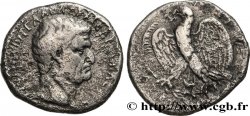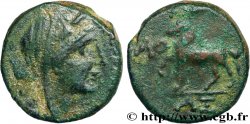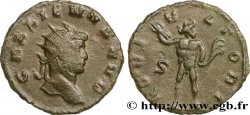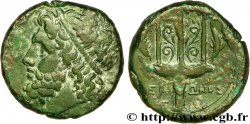v16_0496 - GALBA Tétradrachme syro-phénicien
MONNAIES 16 (2002)
Prezzo di inizio : 130.00 €
Valutazione : 220.00 €
Prezzo realizzato : 130.00 €
Numero di offerte : 1
Offerta maxima : 130.00 €
Prezzo di inizio : 130.00 €
Valutazione : 220.00 €
Prezzo realizzato : 130.00 €
Numero di offerte : 1
Offerta maxima : 130.00 €
Tipo : Tétradrachme syro-phénicien
Data: an 2
Nome della officina / città: Antioche, Syrie, Séleucie et Piérie
Metallo : argento
Diametro : 27 mm
Asse di coniazione : 12 h.
Peso : 14,49 g.
Grado di rarità : R1
Commenti sullo stato di conservazione:
Beau portrait. Légèrement décentré au droit. Exemplaire convenable pour ce type
N° nelle opere di riferimento :
Pedigree :
Cet exemplaire est le 0100_010 de la base TSP
Diritto
Descrittivo diritto : Tête nue de Galba à droite (O°).
Legenda diritto : [AUTOKRATWR] GALBA KAISAR SEBASTOS
Traduzione diritto : (L'empereur Galba césar auguste).
Rovescio
Descrittivo rovescio : Aigle debout à gauche sur une couronne, les ailes déployées, tenant une couronne dans son bec ; devant dans le champ à gauche, une palme verticale.
Legenda rovescio : ETOUS B
Traduzione rovescio : (an 2).
Commento
Le style hellénistique de ce portrait très particulier montre à cette époque la présence en Orient d'une véritable école de gravure, très différente de celle de Rome. La légende grecque porte en revanche des traces de romanisation avec l’abandon du sigma pour le C majuscule et du Pi pour une P, lettres que nous n’avons pu reproduire dans la légende, faute de caractères spéciaux. Les auteurs du RPC ont répertorié 32 exemplaires. Pour notre type avec 17 tétradrachmes, nous avons 7 coins de droit.
The Hellenistic style of this very particular portrait shows the presence in the Orient at this time of a true school of engraving, very different from that of Rome. The Greek legend, however, bears traces of Romanization with the abandonment of the sigma for the capital C and of Pi for a P, letters that we have not been able to reproduce in the legend, due to a lack of special characters. The authors of the RPC have listed 32 examples. For our type with 17 tetradrachms, we have 7 obverse dies
The Hellenistic style of this very particular portrait shows the presence in the Orient at this time of a true school of engraving, very different from that of Rome. The Greek legend, however, bears traces of Romanization with the abandonment of the sigma for the capital C and of Pi for a P, letters that we have not been able to reproduce in the legend, due to a lack of special characters. The authors of the RPC have listed 32 examples. For our type with 17 tetradrachms, we have 7 obverse dies








 Segnalare un errore
Segnalare un errore Stampate la pagina
Stampate la pagina Condividi mia selezione
Condividi mia selezione Fai una domanda
Fai una domanda Consegnare / vendere
Consegnare / vendere
 Descrittivo
Descrittivo















